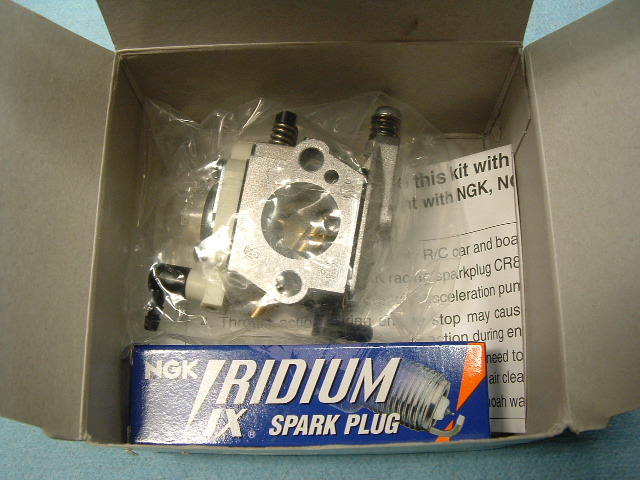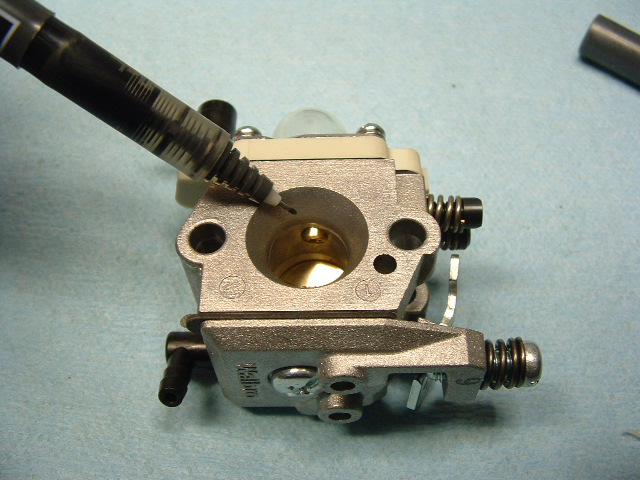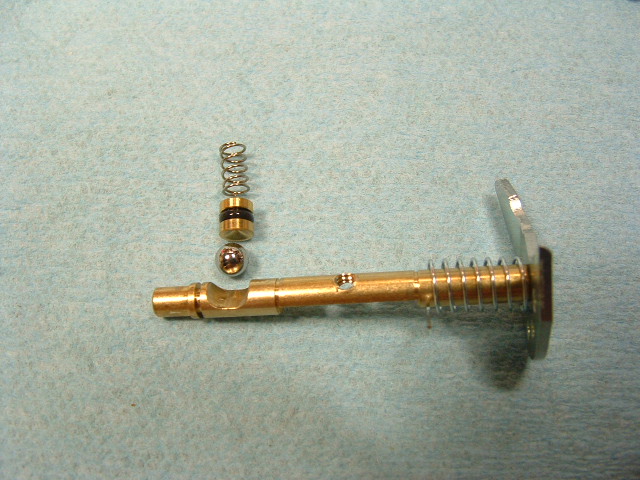
Our review of the Zenoah Racing Kit for the G231/G260 PUM engines...by Scott Schneider
My first impression:
The kit is not packaged with any "bling" to what it contains or its intended application. Just a plain white box with simple descriptive writing on it.
How boring......
Contained within the kit:



- 1 full page of simple instructions and disclaimers stating KOMATSU ZENOAH does NOT cover warranty issues with this kit or the engine it is installed upon. Simple enough, it’s a Racing part!
- 1 NGK brand CR8HIX IRIDIUM Spark plug
- 1 WALBRO WT-813 Series Carburetor, purge primer equipped.
---------------------------------------------------------------------------------------------------
 * Spark plug is a special "RACING" type that utilizes a VERY thin exotic metal center electrode. Grounding post is tapered at tip to centralize the spark energy.
* Spark plug is a special "RACING" type that utilizes a VERY thin exotic metal center electrode. Grounding post is tapered at tip to centralize the spark energy.
These types of plugs, because of the small cross section of center electrode, create a hotter and stronger spark to ignite the air/fuel mixture. Because the HEAT of ignition is on such a small surface, the material the center electrode is made of needs to be a lot tougher...thus the higher plug cost!
* BTW, these plugs are a tad longer than the stock CMR's by just over 1/2" so if cowl clearance is an issue, you won't be able to use it...bummer.
Editor's note: There is an article here on Modelgasboats.com on how to shorten a spark plug should you want to try it. CLICK HERE to see this article.
The Carburetor.... Very Trick Indeed!
At first glance it resembles a WT-257...but it contains the purge primer set up like a stock carburetor has. Looking closer though reveals it to be NOTHING like a WT-257.
I am going to get into this deeper than likely required, but due to the UNIQUE nature of the Carburetor's configuration I feel it's worth noting.
* Walbro has equipped this carburetor with an Accelerator Pump Circuit that gets actuated by throttle shaft rotation. Photos will show "some" of the parts that make this circuit tick.
* Next is the HIGH speed delivery discharge. NO longer do we find just a hole on the edge of the venturi, but instead we find a brass delivery jet pressed into the body projecting into the carburetor bore slightly behind the apex of the venturi.... interesting.



OK, I have to confess, this configuration while NEW & GROUND BREAKING for a hobby engine, is actually a design that has been around for 25+ years, and just applied to this specific carburetor.
** Note: The actual size of the throttle bore and venturi bore are the same as the 257,488,771 and stock carb. ( .625 on butterfly and .500 at venturi.
The CFM rating while not measured, should be very close to the others.
So here it is, the "What & Why" of how these changes make a better carburetor for us model boaters.....
The Accelerator Pump Circuit
Having it allows the WALBRO engineers to calibrate the carburetor to have very crisp and accurate fuel delivery attributes. The low speed circuit can be set up so the engine will run very clean at slower engine speeds without loading up, and have a high speed circuit that is better isolated from the low circuit giving it finer mixture control at the needle. The accelerator circuit, because it is operated by throttle shaft rotation, gives the engine a SHOT of fuel if opened quickly, or has little effect if opened slowly. (Pump still works, but no shot is given, just a bleed out of fuel as throttle is slowly applied).
This allows an engine to run REALLY CRISP, yet NOT stumble when the throttle is suddenly opened. That’s a GREAT thing!
Next is that odd High Speed Delivery Jet....
First off the brass jet actually contains a "Disk" style check valve right at the outlet. This design allows vacuum from the venturi to lift the disk and let metered fuel flow out into the air stream, BUT ... when air flow changes direction within carburetor bore, the disk is blown down over the discharge hole shutting off the fuel flow from jet.
* What this does is help eliminate excessive fuel fogging / spit back out of the carburetor. Also because fuel is discharged out away from the edge of the venturi, it aids in having better fuel atomization.
Note: All piston ported 2 strokes exhibit fuel spit back to some extent. The greater the intake duration the worse this gets.
So there it is.... Simple bolt on tricks provided by the manufacturer. Pretty darn cool!!
Testing Results
After a day's running of this Walbro pump carburetor installed on a modified Zenoah 260 running within an Aeromarine Conquest cat, the following attributes are noted.
* Low speed needle can be set for an EXCELLENT bench idle, lean enough to idle through an entire tank of fuel if you wanted to. Once the boat is launched and running at lower RPM, the throttle response is INSTANT coming up in rpm without any hesitation what so ever. (Settled in at @ 1 3/8 open)
* High speed was a tad unstable in my testing as I played with props and load on the engine. ( See bold text note below ) As long as the prop load allowed rapid and easy transition up to the higher rpm, the mixture stability was fine. When loading up the engine and making it work hard at higher rpm the carburetor could not figure out what the engine wanted and would bounce around running lean one moment then richer the next.
(Changed out the carburetor to another so a retest with the same prop loading and the engine ran right on mix setting non fluctuating) So I was able to conclude that the WT-813 carburetor would work best on an engine that is set up to run free and at higher RPM than loaded down for torque. ( settled for @ 1 1/2 open)
* Note on High Speed needle instability: The inlet needle has a non-stick coating applied to it so that under storage, until used with fuel, it will keep the needle from sticking against the seat. Simply remove the needle and wipe it down with some alcohol on a soft rag. Remove most of the silver coating so you get down to the RED viton material needle tip is made of. This most likely will cure the heavy load instability issues noted during testing.
The use of the enclosed High Performance spark plug was not really found to be a booster of performance in the boat tested, and actually is very limiting as to where you can use it due to its increased height.
Final Thoughts...
 Overall I would give the kit a thumbs up. The 813 carburetor in a modified engine does work better than the stock choke-equipped carburetor. Also idle and general starting/priming of the engine is far easier than with the WT-257 carburetor that so many choose as an HP after market carburetor.
Overall I would give the kit a thumbs up. The 813 carburetor in a modified engine does work better than the stock choke-equipped carburetor. Also idle and general starting/priming of the engine is far easier than with the WT-257 carburetor that so many choose as an HP after market carburetor.
(Side Note)
Once the carburetor is fully primed and has been run, simply by actuating the throttle several times the carburetor will pump fuel out of the primer circuit into the intake throat allowing you to start the engine without choking. (or flood the engine if you're messing around opening and closing it!)
Scott Schneider - MGB technical staff.


